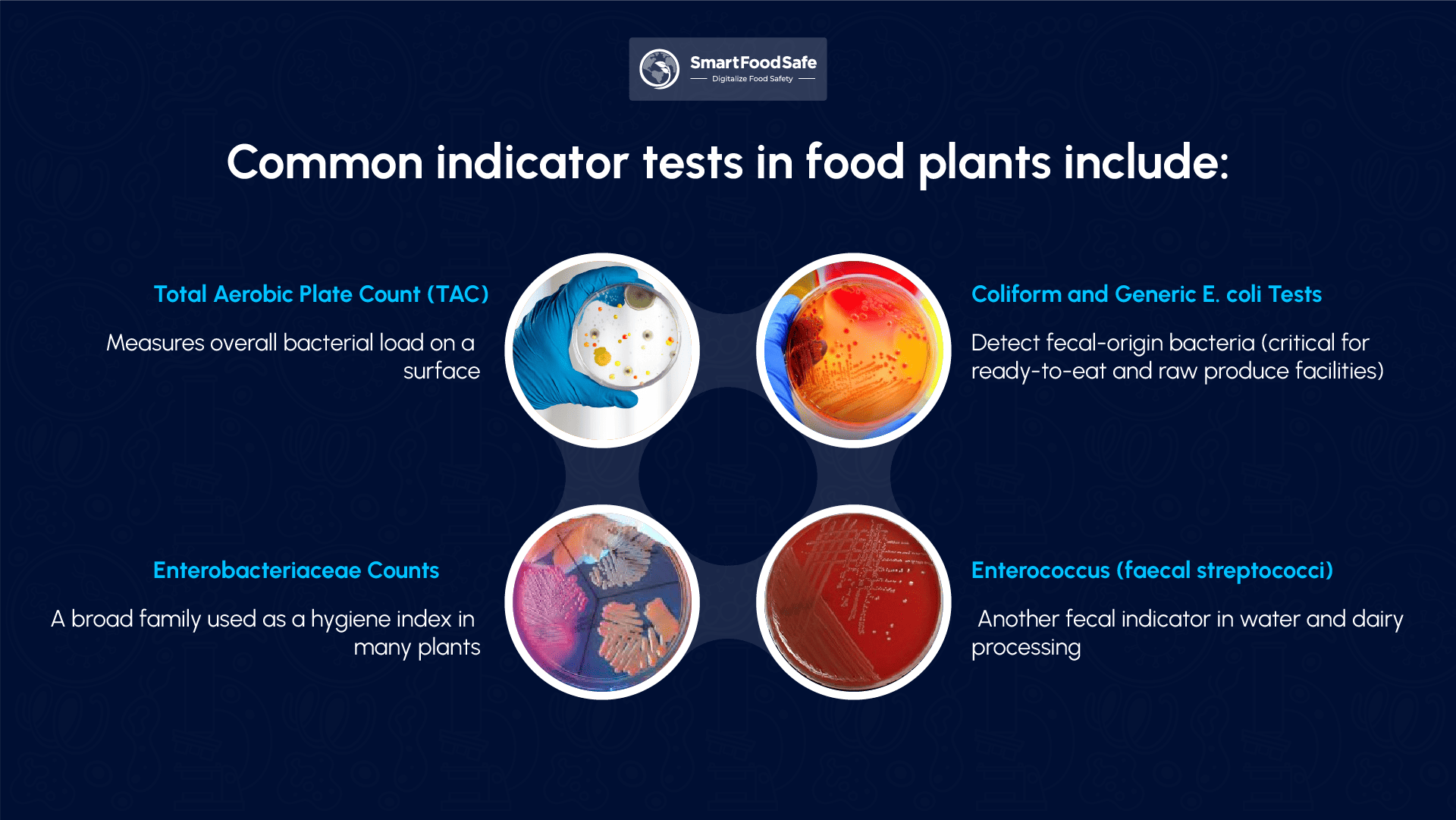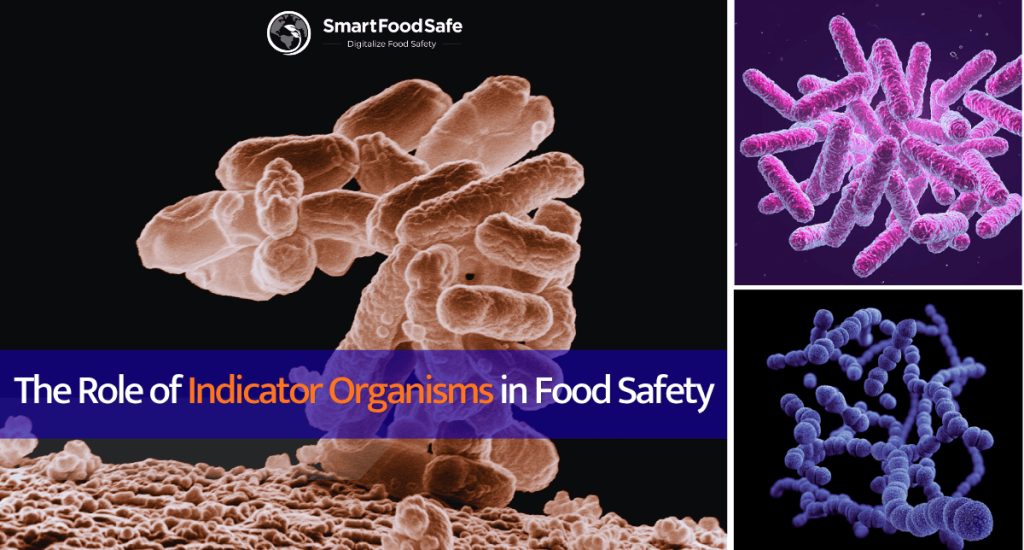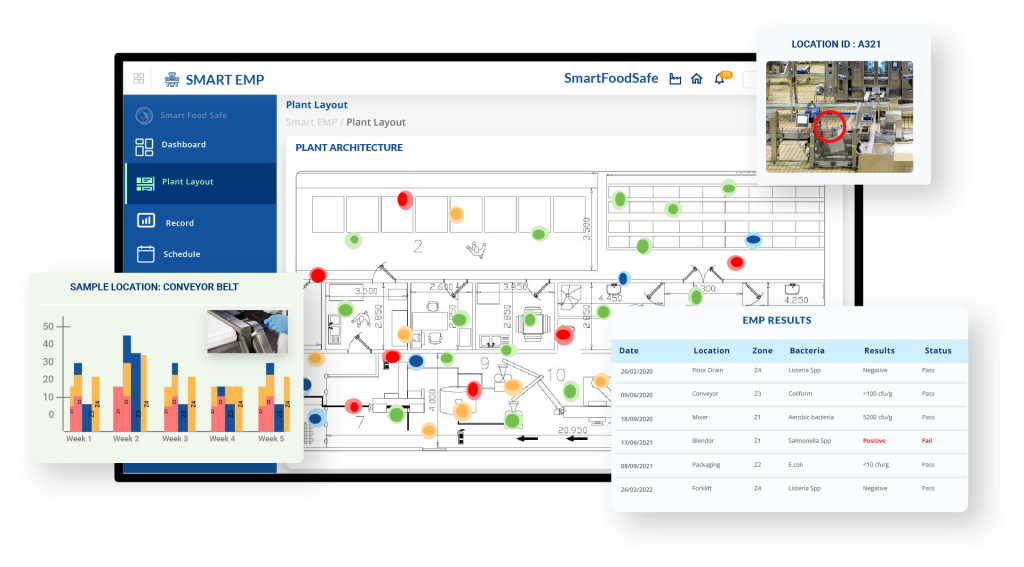
In the food manufacturing world, the best defense against contamination is often invisible. Long before pathogens show up, subtle biological clues appear: harmless microbes quietly signaling that “something’s off”. These are the indicator organisms: quiet guardians that help your Environmental Monitoring Program (EMP) catch problems before they spread.
The pattern endures before contamination strikes, the tiniest microbes sound the first alarm.
The story begins in the late 19th century, when early microbiologists, such as those researching cholera outbreaks in Europe, discovered that some bacteria, such as coliforms, were easily detected but frequently accompanied by deadly pathogens in contaminated sources. By the early 1900s, this "indicator" approach which was prompted by the pressing need to protect public health amid rapid urbanization, had swiftly progressed from water testing to food safety regulations, preventing outbreaks linked to dairy and shellfish. In the modern era, these continue to be our manufacturing frontline defense, announcing problems before they become serious.
What Makes Indicator Organisms Different from Pathogens
To understand their role, it’s crucial to distinguish between pathogens and indicator organisms.
- Pathogens are the actual culprits, microbes that cause foodborne illness, such as Listeria monocytogenes, Salmonella, or E. coli O157:H7.
- Indicator organisms, on the other hand, are typically non-pathogenic. Common examples include coliforms, Enterobacteriaceae, Enterococcus, and total aerobic bacteria (often measured by plate count tests).
These indicator organisms thrive under the same conditions as pathogens, sharing similar temperature, moisture, and pH preferences. So, when they appear in unexpected places, it’s a sign that the environment could also support pathogens if left unchecked.
Think of them as microbial smoke detectors. They don’t cause harm themselves but they alert you early, long before an actual outbreak could ignite.
For example, spotting E. coli in a floor drain or a high plate count on a mixing bowl flags sanitation gaps, small microbial clues that hint at bigger contamination risks ahead.
Significance of Indicator Organisms in Food Processing Environments
Indicator organisms play a crucial role in assessing the overall hygiene and microbial control of food processing facilities. Rather than identifying specific pathogens, these organisms provide a snapshot of how effectively sanitation, handling, and environmental controls are working throughout the production process.
Originally introduced in the early 20th century, indicator testing was used to evaluate fecal or environmental contamination. Today, it remains a cornerstone of Environmental Monitoring Programs (EMP), helping quality teams detect early warning signs of microbial risks before they compromise food safety.
1. Total Plate Count (TPC)
Also known as Aerobic Plate Count or Total Viable Count, TPC measures the total number of aerobic bacteria present in a sample. It offers a broad indication of microbial load on surfaces, in ingredients, or within finished products. High TPC results often signal ineffective cleaning or sanitation, making it a key verification step for hygiene validation.
2. Coliforms
Coliforms are a group of bacteria that can ferment lactose to produce acid and gas. Although once linked mainly to fecal contamination, most coliforms found in food plants are environmental. Elevated coliform levels usually point to post-process contamination or lapses in cleaning, making them reliable indicators of general sanitation effectiveness when used alongside TPC.
3. Enterobacteriaceae (EB)
This broader bacterial group includes all coliforms as well as genera such as Salmonella and Klebsiella. Testing for Enterobacteriaceae helps detect improper cleaning or cross-contamination, especially in moist or protein-rich environments where these bacteria thrive. While EB testing doesn’t confirm the presence of specific pathogens, it provides a useful measure of hygiene control and environmental cleanliness.

Monitoring indicator organisms offers an early warning to validate sanitation, boost cleaning efficiency, and protect product safety.
When hygiene is excellent, indicator counts should be very low or absent. Any unexpected spike in indicators, especially above the established baseline, is a warning sign that sanitation practices need attention.
What to do when indicators spike
A single elevated result may be a one-off; repeated positives at the same site is a red flag. When that happens:
- Investigate: Check recent cleaning logs, sanitizer concentrations, maintenance work, and staff activities.
- Confirm: Re-sample and consider targeted pathogen verification if the site is high risk.
- Root-cause: Look for design issues (e.g., dead legs, cracked gaskets, poor drainage) or behavioral problems (cleaning shortcuts).
- Correct and verify: Fix the root cause, adjust procedures or products, retrain staff, and re-test until the site returns to baseline.
Pros and Cons of Using Indicator Organisms in Environmental Monitoring
| Pros: Why They Work | Cons: Where Caution Is Needed |
|---|---|
| Cost-effective & practical Indicator tests are inexpensive and easy to perform frequently, enabling consistent routine monitoring. |
Not pathogen-specific Indicators signal hygiene issues but cannot confirm the presence of particular pathogens (e.g., Listeria or Salmonella). |
| Early warning system Detects hygiene lapses before pathogens emerge, allowing proactive corrective action. |
Potential for false positives Environmental factors like wild yeasts, dust, or moisture may distort results, leading to unnecessary alarm. |
| Simplifies ongoing sanitation checks Tracks cleaning effectiveness and helps validate sanitation programs over time. |
Limited interpretability A positive result indicates risk but doesn’t pinpoint exact contamination sources without further investigation. |
| Supports data-driven decisions Enables trend analysis to identify recurring problem zones or seasonal contamination patterns. |
Risk of overreliance Using indicators without periodic pathogen verification can create a false sense of safety. |
| Low biosafety requirements Harmless indicator organisms reduce handling risks and eliminate the need for containment-level labs. |
May miss emerging hazards Some pathogens behave differently than their indicators, leading to potential blind spots. |
That’s why indicator testing complements and does not replace direct pathogen monitoring. Together, they form a balanced, layered defense system.
Designing an Indicator-Based EMP: Practical Framework
Building an effective environmental monitoring plan starts with understanding your facility’s unique risks. A typical EMP classifies plant areas into zones:
- Zone 1 – Food Contact Surfaces: Conveyors, slicers, mixers
- Zone 2 – Adjacent Surfaces: Equipment frames, walls, drains near production lines
- Zone 3 – General Environment: Floors, forklifts, ceilings
- Zone 4 – Non-Processing Areas: Hallways, cafeterias, loading docks
Higher-risk zones (1 & 2) require more frequent testing, while lower zones (3 & 4) can be monitored less often. Regular swabbing, using consistent methods and areas, builds reliable trend data.
Indicator results that exceed set thresholds should trigger corrective actions such as re-cleaning, reviewing sanitizer concentrations, or redesigning equipment that harbors residue. Over time, tracking these patterns validates your sanitation program and strengthens preventive controls.
Best Practice: Blend Speed with Confirmation, Culture with Context
Modern food safety demands agility and precision. The best environmental monitoring programs balance speed with scientific confirmation, and culture with operational context.
The smartest programs combine multiple tools: routine indicator testing for surveillance, ATP for immediate hygiene checks, and periodic pathogen testing or molecular methods (PCR) for verification. Use indicators for day-to-day decisions and reserve targeted pathogen testing for high-risk zones, trend anomalies, or verification after corrective actions.
Equally important is people: cross-training, clear SOPs, and a culture that treats environmental monitoring as a shared responsibility. Data without action is just paper. When teams see their data visualized through Smart EMP’s digital heat maps and dashboards, they understand contamination trends, recurring hotspots, and seasonal risks in context. Over time, that builds smarter decisions, not just faster ones.
The Smart EMP Advantage
Smart EMP turns environmental data into actionable insights by offering:
- Automated scheduling & corrective actions
- Zone-based plant mapping & heat trend visualization
- Real-time dashboards & alerts
- Regulatory alignment (FSMA, SQF, BRCGS, GFSI standards)
Together, these tools close the gap between detection and action, ensuring that indicator organisms don’t just warn you, but actually help you improve your hygiene system.
Timing is crucial in food safety because it can mean the difference between crisis and control. A single test, a few hours, or an undetected spike in indicator counts can determine whether a product ships safely or makes the news for a recall tomorrow.
We have that critical window of opportunity to take action before damage occurs thanks to indicator organisms. They serve as a reminder that prevention lies in the little things, in the statistics that are often ignored.
And those silent cues become clear when combined with smart tools, making each swab, count, and remedial measure a tale of preparedness and resiliency.
Food safety is ultimately about listening early enough to prevent issues before they arise, not just about identifying them.




